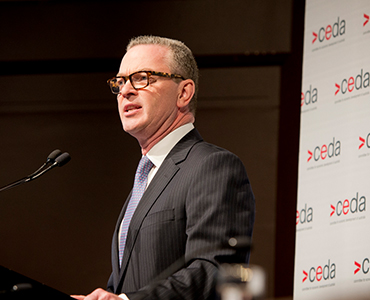The Federal Government’s massive investment in defence capability and industry will provide both long-term economic opportunities and challenges for South Australia, according to speakers at CEDA’s South Australian Defence Industries Overview.
 Addressing the event, Federal Minister for Defence Industry, the Hon. Christopher Pyne outlined the Government’s progress in developing and implementing its approach to defence industry and how it is affecting South Australia.
Addressing the event, Federal Minister for Defence Industry, the Hon. Christopher Pyne outlined the Government’s progress in developing and implementing its approach to defence industry and how it is affecting South Australia.
Mr Pyne said national security and economic security are inseparable and represent the two pillars of the Turnbull Government’s focus.
“National security and economic security, is, in the simplest terms I can put it, what our historic 200-billion-dollar investment in defence capability and defence industry over the next decade is all about,” he said.
“We are looking to develop a sovereign defence industry with the capability, posture, and resilience to meet Australia’s unique defence needs, to the greatest extent possible within our own borders, for the next century.”
The centrepiece of that industry is the $90 billion naval shipbuilding plan that will involve building ships, submarines, surface combatants and minor naval vessels. It is set to deliver 20,000 jobs, the bulk of them in South Australia, he said.
“South Australians know that an investment program on this scale will do more than transform the capability of our Defence Force across our air, land, sea and joint domains, as vital as that is,” Mr Pyne said.
“It will also create highly paid jobs and secure their nation’s, and their state’s, future in shipbuilding and advanced manufacturing as the project reaches deep into the supply chain as well as on to their breakfast tables.”
Mr Pyne said that a strong manufacturing future would also provide investment, jobs, skills development, education and training and other spin offs for the economy.
In a panel discussion following the Minister’s address, questions were raised about whether the local workforce was ready to take full advantage of the opportunities set to come its way.
BAE Systems Australia Chief Executive, Gabby Costigan said she was excited about the prospects for jobs within the defence industry in South Australia, noting the scale of the shipbuilding program will be much bigger than the Snowy River Hydro scheme.
“In essence, South Australia is about to embark on two Snowy River Hydro Schemes,” Ms Costigan said.
“We will create thousands of jobs both direct and indirect over several decades. These jobs will be some of the most skilled people in Australia.”
However, she warned that demand for jobs in ship building will likely outstrip supply. Securing sufficient talent with STEM skills and apprenticeships in steelwork, mechanical and technical trades will be critical for decades to come.
“Let’s promote the avenues this opens to work on some of the most sophisticated kit in the world, which enables those who put their lives on the line for us to have the best chance of coming home safely,” she said.
University of Adelaide Vice-Chancellor and President, Professor Peter Rathjen said South Australia has the opportunity to “create something wonderful” by reinventing the state as a hub for advanced manufacturing.
The trick is, he said, to leverage the defence funding not just to create defence technologies but also to apply those technologies to other areas of human endeavour.
“As we develop things like artificial intelligence, machine learning, big data capabilities, cyber security and the like, people will be able to find unexpected applications in areas like health care, aged care, energy, agriculture and biotechnology – the formation of new businesses we haven’t even thought of yet,” Professor Rathjen said.
“If all we get for $90 billion (from the naval shipbulding plan) is $90 billion worth of submarines and frigates and a workforce that is employed for 10 to 20 years then we will have failed.
“But if we can get $90 billion worth of reinvention for this state around advanced manufacturing, high value future facing jobs – things that will not just keep our young people in this state but draw other young people to this state – then we’re on to something that really matters.”
KPMG Lead Partner, Defence, Mike Kalms said that, although the risks of not having the right size and shape workforce in Australia are real, progress is being made. He said the defence industry is unusual in having a lot of large and small enterprises but not much in the middle.
He said, with the overall $200 billion investment in defence industries, we should expect to get some medium-sized enterprises. But, that may require a change of thinking in the defence sector around working with entrepreneurs and taking risks.
“To create the 20 to 40 mediums that I think we deserve out of $200 billion investment, that probably means we’ve got to pour in several hundred entrepreneurs into the ecosystem that we’re creating and I don’t see that number of people being introduced to our sector at this time,” he said.
“So, as we build this workforce, as we grow the skills base… can we also think about the entrepreneurs who perhaps right now aren’t aspiring to our sector. But if they did, as they are in FinTech, AgTech and BioTech … they could perhaps be that crop of defence mediums that our $200 billion investment should be expected to grow.”